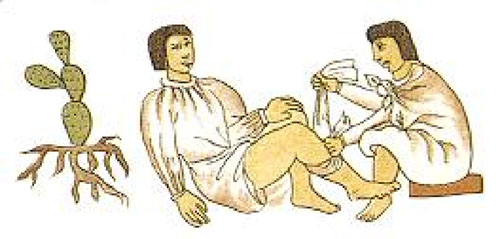Introduction
To assess the accuracy of the descriptions of pre-contact health, such as those found in The Book of Chilam Balam of Chumayel, historians of Meso-American cultures must be creative; texts written by native peoples are scarce. Although the Aztecs had a written language, Spanish priests often burned Aztec texts in an effort to weed out signs of backsliding among Christian converts. To replace the written word, historians have reconstructed health patterns from two very different types of sources.
Paleopathology, or the study of ancient skeletons for signs of disease, has shown that the native peoples of the Americas suffered from nutritional deficiencies. With a corn-based diet, the Aztecs were susceptible to dental caries. The skeletons also indicate a high infant mortality rate, a pattern the Aztecs shared with European cultures. In addition, skeletal remains reveal that violence — whether intentional, as in war, or accidental — also threatened the health of native peoples.
Artwork, too, can offer historians insight into the health and disease experiences of a culture. Below are two images from the Florentine Codex, the Aztec history of their civilization through the conquest, as it was told to and transcribed by Bernardo de Sahagún, one of the Spaniards who accompanied the Cortés expedition and who remained in New Spain as a priest ministering to the Indians.
Questions to Consider
Documents

(click to enlarge)

(click to enlarge)
Sources:
Aztec Medicine. http://library.thinkquest.org/
C006206F/fotos_america_i.htm#lm.
Aztec Ailment. http://latinamericanstudies.org/florentine-codex-2.htm.
Next >>>
<<< Return to Evidence
|